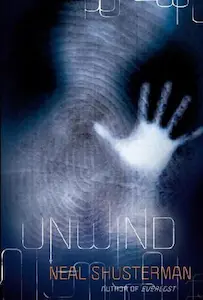Unwind - Summary
Neal Shusterman

Introduction
In Neal Shusterman’s thought-provoking novel, “Unwind,” the author explores a dystopian society where the practice of “unwinding” has become a controversial solution to the issue of unwanted teenagers. This book summary will delve into the key elements of the story, providing examples and anecdotes from the book to illustrate the themes and challenges faced by the characters. Through its gripping narrative and compelling characters, “Unwind” raises important ethical questions and challenges readers to reflect on the value of human life.
The World of “Unwind”
Set in a future society, “Unwind” presents a world where the Second Civil War was fought over reproductive rights. As a result, a compromise was reached, known as the Bill of Life, which allows parents to “unwind” their children between the ages of 13 and 18. Unwinding is the process of harvesting all the organs and body parts of a teenager, ensuring that every part of them lives on in different individuals.
The Protagonists: Connor, Risa, and Lev
The story primarily follows three main characters: Connor, Risa, and Lev. Connor Lassiter, a rebellious and impulsive teenager, finds himself on the run after discovering that his parents have signed the unwind order for him. Risa Ward, a talented orphaned pianist, faces unwinding due to budget cuts at the state home. Lastly, Lev Calder, a tithe raised to believe that being unwound is a noble sacrifice, is prepared to fulfill his destiny.
The Journey Begins
Connor, Risa, and Lev’s paths intertwine when they escape from their respective fates and join forces to survive. As they navigate through a society that views them as disposable, they encounter various challenges and meet other characters who have been affected by the practice of unwinding. Shusterman skillfully weaves these encounters into the narrative, shedding light on the different perspectives surrounding unwinding.
A Glimpse into Unwinding
Throughout the book, Shusterman provides vivid descriptions of the process of unwinding. One example is when the characters visit an airplane graveyard, where decommissioned planes are used as harvesting grounds for unwound teenagers. This haunting setting emphasizes the callousness of the practice and the dehumanization of the victims. The author’s use of descriptive language creates a chilling atmosphere, leaving a lasting impact on the reader.
Ethical Dilemmas and Societal Reflections
“Unwind” raises profound ethical questions about the value of human life and the consequences of playing God. Shusterman skillfully presents multiple perspectives on the issue, allowing readers to grapple with their own beliefs. For instance, Lev initially embraces his role as a tithe, believing that being unwound is an honorable sacrifice. However, as he witnesses the horrors of unwinding firsthand, his perspective begins to shift.
The Role of Technology
Shusterman also explores the role of technology in a society that condones unwinding. In the book, advancements in medical science have made it possible to keep every part of a person alive, albeit in different bodies. This technological aspect adds a layer of realism to the story, forcing readers to consider the potential consequences of scientific progress and its impact on humanity.
The Power of Relationships
Amidst the darkness of the world presented in “Unwind,” the novel also highlights the power of human connection and the resilience of the human spirit. Connor, Risa, and Lev form a bond as they rely on each other for survival. Their relationships evolve throughout the story, showcasing the importance of empathy and solidarity in the face of adversity.
The Fight for Change
As the narrative unfolds, the characters find themselves drawn into a resistance movement against unwinding. They join forces with others who oppose this practice, seeking to bring about change and challenge the societal norms that allow unwinding to persist. This theme of resistance and fighting for justice adds depth to the story, inspiring readers to question their own roles in shaping a more compassionate world.
Conclusion
In “Unwind,” Neal Shusterman presents a chilling yet captivating vision of a society that commodifies human life. Through the experiences of Connor, Risa, and Lev, the novel explores profound ethical dilemmas, the consequences of technological advancements, and the power of human connection. Shusterman’s masterful storytelling and use of examples and anecdotes from the book engage readers, urging them to reflect on the value of every individual’s life and the importance of fighting for a more compassionate society. “Unwind” serves as a poignant reminder of the potential consequences of societal choices and the responsibility we bear in shaping a future that upholds the sanctity of life.